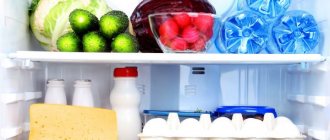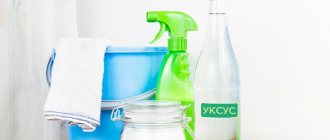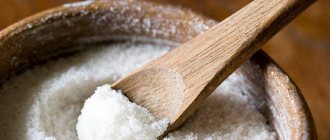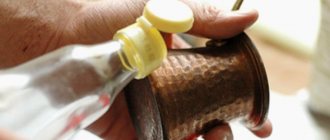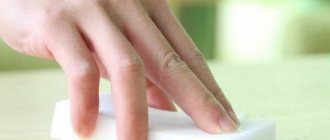In many houses, the most visited room by residents is the kitchen, or more precisely, its corner where the refrigerator is located.
The doors of electrical appliances are opened many times every day and it is no wonder that
a large number of various traces – stains of grease, vegetables – often remain on their surface and on the sides of the refrigerator . Therefore, every housewife sooner or later faces the question: how to properly and quickly clean the refrigerator?
What can't you use?
Regardless of the type of surface of the refrigerator - made of stainless steel or painted metal - not all detergents and folk recipes are suitable for cleaning.
Preparations containing chlorine or acids can damage the outer layer and contribute to the appearance of rust and blistering of the paintwork. Detergents containing abrasive components are also unsafe.
It is a mistaken belief that “Whiteness” or preparations intended for the care of plumbing fixtures are also suitable for washing a refrigerator - concentrated solutions will paint a white electrical appliance a yellow tint and leave permanent stains on the glossy surface of the unit .
A few words should be said about the “harmlessness” of products created by manufacturers specifically for the care of refrigerators: if they are left on the surface of the refrigerator for a long time, there is a high probability that chemicals can get under the paint through microcracks and cause swelling and cracking of the protective layer.
It is unacceptable to use brushes with hard bristles or sponges during the cleaning process , which can scratch the electrical appliance.
Some ready-made cleaning products can damage the floor covering, so when cleaning, do not forget to place an old rug under the refrigerator.
Preparing for cleaning
Before you start cleaning, it would be a good idea to carry out a number of preparatory activities:
Move the refrigerator away from the wall (this allows free access to the unit from either side).- Remove food (during the extraction process, the contents must be sorted out and anything spoiled must be thrown away).
- Prepare the things necessary for cleaning (rubber gloves for hands, a basin of water, sponges, rags, paper towels).
- Choose a detergent.
Special chemical compounds help to clean as quickly as possible, and folk remedies help to clean the refrigerator without much expense or harm to health.
Folk remedies and recipes
Using traditional methods, you can not only remove dirt from the refrigerator, but also disinfect its surface.
Laundry soap
The fatty acids and alkalis contained in this product make it a very effective product for caring for the outside of the refrigerator:
- Place a container of water on the stove and heat the liquid;
- grate a small piece of soap using a coarse grater;
- pour the shavings into hot water and stir until a viscous liquid mass is formed;
- With the soft side of the sponge, apply the mixture to the surface of the kitchen appliances, paying attention to the protrusions and crevices, including the magnetic seal;
- leave the solution for 5 minutes and rinse with plenty of water.
After finishing work, be sure to wipe the refrigerator dry with gauze or other lint-free cloth.
Alcohol and vinegar
When diluted (half with water), ethyl alcohol and table vinegar quickly deal with significant stains by simply wiping.
If you find pinpoint stains on the refrigerator that cannot be removed by any means, make cotton swabs or use a cotton swab, soak them in undiluted alcohol or vinegar and apply to the stain for 2-3 minutes.
As soon as you notice that the cotton wool has turned the color of the speck, change it and do the procedure again. This must be done until the contamination disappears.
You can use vinegar to clean a stainless steel stove, read more in this article.
Technical soda
The substance has unique cleaning properties and can cope with almost any type of dirt:
- pour a little soda ash into a deep plate and add hot water in such an amount to make a paste;
- Use a spoon to transfer the mixture onto a piece of cloth and apply it to the stain. Hold in this position for 4-5 minutes;
- remove the mixture and scrub the contaminated area with a damp sponge.
IMPORTANT! The pH value of soda is 8-12 units, so the alkali should not be kept on a painted or chrome surface for longer than the specified time.
Soda ash is also an excellent help if you need to clean the oven from grease.
Dishwashing liquid
Dishwashing detergents in liquid or gel form contain surfactants that are designed to remove grease, so they can also be used to “wash” the refrigerator:
- dilute a few drops of the product in 100 ml of hot water, stir thoroughly - you should get plenty of foam;
- soak a soft cloth in the solution and wipe the outside of the refrigerator.
To remove any remaining product, you will have to rinse the cloth in clean water and wipe the refrigerator several times.
Soda solution
This product can clean any surface and is also suitable for cleaning a refrigerator. In order for the unit to become clean again, it is necessary to perform certain actions, which will include the following:
- Half a liter of water is poured into the container and a couple of spoons of the bulk component are poured.
- The composition is thoroughly mixed until a homogeneous consistency is obtained.
- The product should be applied to the contaminated areas and left to act for a quarter of an hour, then clean the surface using the hard side of the sponge. Do not overdo it, otherwise scratches will form.
- Remove any remaining substance with a damp cloth, then wipe dry with a cloth.
Household chemicals
Manufacturers have developed a series of special products in the form of gels, wipes and sprays for caring for the external surfaces of the refrigeration unit:
- EFSTO is a spray that does not contain abrasive components, is easy to use and effective in removing stains from water, grease, and burning. Spray the product on the side walls, top and door of the refrigerator and wipe the surfaces with a dry cloth.
- EdelWeiss is a solution with a pleasant smell and liquid consistency that quickly removes stains of various origins. You can use the product in “spray” or “foam” mode, which simplifies the cleaning process and saves the consumption of cleaning liquid.
- Spray foam “Clean Refrigerator” based on plant components is effective in combating food stains: stains from fruits and vegetables, grease, traces of fish and meat. Apply the foam for 5 minutes and wipe the surface dry.
- House Lux wet wipes are a product suitable for both general cleaning and for quickly removing dried grease stains. To give your refrigerator a sparkling appearance, all you have to do is wipe down all its parts thoroughly.
ATTENTION! When using wipes, a foamy substance remains on the surface; after cleaning, wipe it with a damp, then dry cloth.
Do you trust folk recipes?
Not really
Features of cleaning the refrigerator from yellowness
It is always easier to prevent a problem than to solve it, so it is advisable to carry out regular competent care of household appliances and not bring the situation to a deplorable state. It is important to regularly keep the refrigerator compartment clean. What does that require?
- It is important to ensure that there is no accumulation of various types of pollution every day. It is better to immediately remove small dirt with a damp cloth than to wash off dried dirt later.
- It is advisable to wipe the unit doors at least once a week to remove greasy marks and fingerprints.
- There is no need to place dirty dishes on the shelves.
- It is imperative to constantly monitor the freshness of products. Anything that has gone bad goes straight into the trash bin.
- All products must be stored in closed containers or other containers.
- You need to clean your refrigerator at least once every 2-3 months.
- When cleaning, do not use hard brushes, sponges or scrapers, as they can damage plastic surfaces and leave scratches and abrasions. A soft sponge and liquid cleaners work best.
It is optimal to carry out routine maintenance of a refrigerator without defrosting once a week - you need to wipe it outside and inside, including the rubber seal, and throw away everything that has accumulated in excess during the week.
How to wash without streaks?
A perfectly sparkling surface can be achieved if you spend a little more time and very thoroughly wash the refrigerator with clean water after using detergents.
After this procedure, you need to wipe the refrigerator dry with a microfiber cloth: paper products or cotton rags will be left on the surface of the fiber.
Cleaning the freezer
If the refrigerator is not equipped with the NoFrost system, the freezer will have to be defrosted from time to time. You can speed up this process with hot water in several ways:
- Spraying the chamber walls with a spray bottle.
- Placing an open pan or closed plastic bottles with hot water in the chamber.
- Using a hot water heating pad.
- Using a fan.
The freezer requires careful care.
After defrosting, wipe all drawers and walls with a damp cloth. In all cases (except the last one), as the water cools, it must be replaced with hot water.
Important! Heat from a hairdryer or fan should not fall on the sealing rubber, otherwise it will begin to lose its elasticity faster.
How to remove different types of contaminants from the surface?
How to get rid of fat at home?
Drops of animal or vegetable fat, soot and soot from a working stove can be washed off well using regular dishwashing detergent:
- drop a little gel onto a sponge, lather and apply to stains;
- After 1-2 minutes, try gently rubbing the stain with an old toothbrush: its bristles are no longer so hard and the risk of scratching the paint layer is minimal. If the fat “sticks”, moisten the area with gel again and repeat the process;
- Rinse the area with clean water.
Yellowness
A yellowish tint on the outside of a white electrical appliance occurs due to irregular maintenance..
Food residues eat into the paintwork and can no longer be removed using conventional means:
- soak a cotton pad in ethyl alcohol and wipe the area that has changed color. Do not keep the cotton wool pressed to the surface for a long time; it is better to repeat the procedure several times;
- A 3% hydrogen peroxide solution helps remove yellowness well. The method of application is similar to using alcohol.
ATTENTION! After treating with aggressive substances, be sure to rinse the surface area with clean water and dry.
Stickers
Traces from labels or tape can be easily soaked using vinegar essence, alcohol/vodka or vegetable oil:
- Apply any of the listed products to a piece of cotton wool and apply it to the adhesive area, leave for 10 minutes;
- drop liquid soap onto a sponge, lather and wipe off the glue;
- rinse with water and dry with a dry cloth.
Effectively removes stains of this type VD-40 is an aerosol preparation designed to protect parts from corrosion. It contains white spirit, thanks to which a cotton pad with the applied composition will remove the glue very quickly.
REFERENCE! If you are unable to remove the sticker, try directing a stream of hot air at it (using a household hair dryer) - the glue will soften and it will be much easier to remove it.
Mold
Most often, mold occurs on the outer and inner sides of the rubber seal.
It is convenient to remove stains with a toothbrush dipped in table vinegar or a solution of hydrogen peroxide:
- moisten the sponge with water and wipe off external dirt from the seal;
- Apply the product to a toothbrush and thoroughly clean all deep folds;
- Wipe with water and be sure to dry.
Rules of care
All work to ensure the cleanliness of a kitchen electrical appliance must begin from the moment of its purchase and installation.
Transportation
The refrigerator, despite its apparent solidity, is a rather fragile device, and improper transportation can lead to damage to the refrigerator . Therefore, manufacturers recommend transporting kitchen appliances in a vertical position - this will reduce the risk of damage to its parts, including the protective coating, and will prevent oil leakage from the compressor.
This option is not always convenient; the height of some models exceeds two meters, so study the information on the packaging: it should indicate which side the refrigeration device can be placed on.
There is no need to worry about the serviceability of parts and assemblies - as a rule, manufacturers take care of this by laying foam plastic in the box. But the integrity of the outer covering is your concern, so protect the unit with thick polyethylene.
Upon arrival, remove the film and treat the entire outside of the refrigerator with detergent, followed by wiping dry.
If you are transporting an old refrigerator and there is no original packaging, then follow this rule: place the electrical appliance so that the tube for the refrigerant outlet from the compressor is directed upward.
During transportation, try to avoid sharp braking and high speed on uneven roads - this will protect the refrigerator from shocks and strong vibrations.
Installation
- Think in advance where the new “resident” will stand in your kitchen. The convenience and accessibility of all surfaces of the unit during further operation depends on the choice;
- It is unacceptable to install a refrigerator near heating appliances or stoves. As a last resort, separate it from the heat source with a cabinet or decorative partition;
- the proximity of moisture is also undesirable: operating an electrical device in such conditions is unsafe for life;
- Being near a place intended for washing dishes (sink, tap) can negatively affect the protective layer of external surfaces: in the process of cleaning dishes, aggressive detergents are often used, drops of which can get on the refrigerator.
After determining the location for the refrigerator and installing it, wait at least 2 hours for condensation on the surfaces of the functional elements to evaporate, especially if the electrical appliance was transported during the cold season. After the specified time has passed, connect the refrigerator to the power supply.
Cleaning
The main principle for keeping the device clean is regularity and consistency of care . This rule is relevant for any household items and devices.
For daily cleaning, a simple wipe of all external parts of the refrigerator with a microfiber cloth will be enough; the same material must be used for more thorough cleaning. If your refrigerator smells bad, use the tips in this article.
Do not use hard sponges under any circumstances - in addition to damaging the protective layer and possible rusting of the refrigerator, dirt and grime will become clogged with microdamages much faster, and removing them will not be so easy.
Cleaners
Soap solutions are the most gentle on the outer surface of the refrigerator.
You can make this tool yourself:
- mix water and table vinegar in equal parts;
- add 1 drop of liquid soap and 1 drop of lemon, tea tree or any other essential oil that has antimicrobial properties and a pleasant aroma;
- pour the mixture into a spray bottle and spray on the contaminated area;
- wipe with a cloth and dry.
This solution will also perfectly help to clean the gas stove from grease at home.
Polishing
To add shine, use a special furniture polish, auto wax, or apply a few drops of vegetable oil to a dry cloth and rub into the surface of the refrigerator.
Reasons why a stainless steel refrigerator gets dirty on the outside
The main reasons for contamination of the external surfaces of a refrigerator made of stainless steel are the following:
- Dust settled on the surface of the refrigerator walls.
- Fingerprints left by the owners when opening and closing the door.
- Drops of fat and soot. This type of contamination can occur on the refrigerator if it is placed next to a gas stove.
- Various stickers on the external surfaces of the refrigerator.
- Yellowness that appears on the outer surfaces of the old unit.
Household dirt from the refrigerator should be washed off with usual detergents. It will be much more difficult to get rid of grease and soot, yellowness and stickers. Removing such contaminants can be a real challenge. This will require special medications.
Despite the quality and durability of stainless steel, improper care of the external surface of the refrigerator can lead to damage to the highest quality device and lead to the loss of its beauty. To ensure that your household appliance lasts a long time, follow our instructions.
Adviсe
- The handles of the unit can simply be cleaned with ordinary dishwashing detergent. It is also easy to remove different types of stains using toothpaste;
- You can get rid of soap stains with window/glass cleaner. Spray the solution and wipe with a dry cloth - the surface will shine;
- When cleaning the refrigerator, do not forget about the condenser grille located at the back of the electrical appliance - remove dust from it with a wide brush or dry cloth.
The cleanliness of a refrigeration appliance is no less important than personal hygiene: after all, it stores the food you eat.
Careless maintenance can turn your refrigerator into a haven of bacteria and mold. Therefore, regular cleaning will not only rid you of pathogens, but the refrigerator will pleasantly please the eye with its clean shine.
Cleaning schedule or maintaining cleanliness
To prevent cleaning your refrigerator from taking up an hour each time, make it a rule to clean things up often, but little by little. How much time do you spend in the kitchen waiting? The casserole is languishing, the food is heating up, the dough is rising - at this moment it costs nothing to walk with a damp cloth along the walls and shelves of the refrigerator. Do this every day, and spring cleaning will no longer be a challenge.
The handle is the dirtiest place in the refrigerator. Wipe it first.
Throw away spoiled food . Did you know that Russians throw away a quarter of food because it has expired? We buy food for future use, not knowing what the refrigerator is filled with. Check your products weekly before going to the store. Throw away anything that's spoiled and make a list of what you need. This way you will save money and keep your kitchen tidy.
Mold multiplies instantly. One rotten vegetable in a week will “infect” the entire fruit and vegetable assortment and add more time to harvesting. Throw away such pockets of infection without regret.
If these rules are followed, general cleaning will be required once a month. Wash off stains on and inside the refrigerator, brush off dust from magnets, remove old notes and stickers - that is, refresh every corner.
